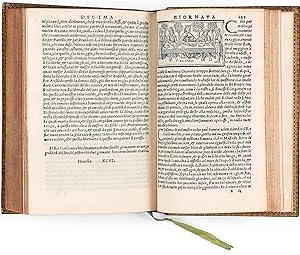Beschreibung
4° (190x118 mm). Collation: AA8, a-z8, &8, [cum]8, [rum]8, A-O8, P10. [8], 329, [1] leaves. Italic and roman type. Woodcut printer s device on the verso of fol. P10v. Blank spaces for capitals, with printed guide letters. Large woodcut on fol. a1r, at the beginning of the Proemio (74x93 mm) and subsequently repeated six more times (fols. d5v, y6r, [cum]6r, A7v, F3v, and H7v), representing Boccaccio s brigade of storytellers seven women and three men seated in a garden, with the figures labelled on the block. Ninety- six smaller woodcut vignettes (43x70 mm), including one repeat, with most of these figures labelled on the block. Late eighteenth-century red morocco, covers framed within triple gilt fillet, a small flower at each corner. Smooth spine, divided into compartments by narrow gilt ornamental rolls. Small gilt tool work in the compartments, the title decamerone del boccaccio in gold. Board edges gilt tooled, marbled pastedowns and flyleaves, inside dentelles, pale green silk bookmark. Gilt edges. A few minor scratches to the upper covers. A very fine copy, first and last leaves slightly dusted. Provenance: from the library of the great collector and politician from Naples Luigi Serra, 4th Duke of Cassano (1747-1825; ownership inscription Del Duca di Cassano on the verso of the front marbled flyleaf). The first Giuntine edition of Boccaccio s masterpiece, a finely illustrated edition very rarely found on the auction market. The 1516 Decameron is introduced, on the verso of the title-page, by an address to the reader ( messer giovanni bocchaccio al lectore ), in which the printer Bernardo Giunta, disguised as Boccaccio himself, praises the Giuntine edition over all others and praises Filippo Giunta s initiative of recovering Boccaccio s original text. This is the first textual evidence available in an edition which indicates that Boccaccio was beginning to appeal to scholarly readers (R. Daniels, Boccaccio and the Book, p. 108). The edition occupies an important position in the textual history of the Decameron, for while it is mainly based on the previous Florentine edition, it was corrected using early manuscripts, or as Bernardo Giunta states piu testi dallo originale transcripti (fol. AA1v) possibly including a manuscript transcribed from authorial originals. Further, the Decameron of 1516 offers the first appearance in print of three additional novellas then erroneously attributed to Boccaccio and nuouamente ritrouate (fol. N6r), i.e. recently rediscovered : the anonymous Bonaccorso di Lapo Giovanni, the Bianco Alfani, possibly composed by Piero di Filippo del Nero, and above all the Grasso Legnaiolo, one of the most famous novellas of the Renaissance, now generally attributed to the Florentine Feo Belcari (1410-1484). The inclusion of these works suggests the use of a still unidentified manuscript containing these novellas, whose language and narrative share characteristics with the Decameron. The woodcuts illustrating this Florentine edition are highly praised, and rightly so. They are reverse free copies of the vignettes included in the first illustrated Decameron printed in Italy, which was issued in Venice in 1492 by Giovanni and Gregorio de Gregori. A great success, the Venetian illustrative set was subsequently adopted by other Venetian printers such as Manfredo Bonelli, for the Decameron of 1498, and Bartolomeo Zanni, for his editions of 1504 and 1510. There are a few points at which the illustration varies from that in the 1504 edition [printed in Venice by Bartolomeo Zanni], and may depend on the fifteenth-century editions. Apparently someone at Giunta s press began to censor the blocks. On leaves e2v and l6v, parts of the blocks have been cut off or masked; similar scenes later in the volume are left intact (Mortimer Italian, p. 95). It is noteworthy that the rival edition issued by the Venetian printer de Gregori, likewise in 1516, is without illustrations, and that.(cont'd). Bestandsnummer des Verkäufers ABE-1658708504252
Verkäufer kontaktieren
Diesen Artikel melden
![]()
